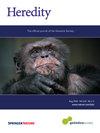Genetic diversity and structure lag the effects of contemporary environmental changes in a platypus meta-population
IF 3.9
2区 生物学
Q2 ECOLOGY
引用次数: 0
Abstract
The platypus is an evolutionary unique mammal on the east coast of mainland Australia and throughout Tasmania. The species is dependent on freshwater ecosystems, is declining throughout its range, and is listed as Vulnerable in the state of Victoria, and Near Threatened on the IUCN Red List. This relatively long-lived species is cryptic and nocturnal making it difficult to study in natural populations. Relatively little is known about its demographic history or the forces that shape genetic variation. We use a unique genomic dataset comprising 2715 single-nucleotide polymorphisms from 545 individual platypuses sampled from five catchments across Melbourne, Victoria. This dataset enabled us to describe the genetic variation across the catchments and test hypotheses relating to migration, effective population size, and potential negative effects of anthropogenic barriers. We found relatively consistent levels of genetic diversity in platypuses across Melbourne’s catchments, moderate levels of within-catchment migration, and genetic differentiation both between and within catchments. This genetic structure is explained by several factors, including isolation-by-river-distance, isolation-by-environment and within-catchment sex biased dispersal at short distances. These patterns are likely explained by a temporal lag between indirect and direct anthropogenic changes to the environmental and genetic variation, and these contemporary analyses likely reflect historical demographic patterns. In addition, we find that anthropogenic barriers such as dams have not measurably affected migration in these catchments. Our study highlights future evolutionary challenges that exist for platypuses in Melbourne’s catchments, which could be representative of their entire range along the east coast of Australia.

鸭嘴兽元种群的遗传多样性和结构滞后于当代环境变化的影响。
鸭嘴兽是一种进化上独特的哺乳动物,生活在澳大利亚大陆东海岸和整个塔斯马尼亚岛。该物种依赖于淡水生态系统,其分布范围正在减少,在维多利亚州被列为易危物种,在世界自然保护联盟红色名录上被列为近危物种。这种相对长寿的物种是隐蔽的和夜间活动的,因此很难在自然种群中进行研究。相对而言,人们对其人口历史或形成遗传变异的力量所知甚少。我们使用了一个独特的基因组数据集,其中包括来自维多利亚州墨尔本五个流域的545只鸭嘴兽的2715个单核苷酸多态性。该数据集使我们能够描述整个流域的遗传变异,并测试有关迁移、有效种群规模和人为障碍潜在负面影响的假设。我们发现,在墨尔本的集水区鸭嘴兽的遗传多样性水平相对一致,集水区内迁移水平中等,集水区之间和集水区内的遗传分化。这种遗传结构可以用几个因素来解释,包括河流距离隔离、环境隔离和集水区内短距离的性别偏向分散。这些模式可能是由环境和遗传变异的间接和直接人为变化之间的时间滞后来解释的,这些当代分析可能反映了历史上的人口模式。此外,我们发现水坝等人为屏障对这些集水区的迁移没有明显的影响。我们的研究强调了墨尔本集水区鸭嘴兽未来的进化挑战,这可能代表了它们在澳大利亚东海岸的整个范围。
本文章由计算机程序翻译,如有差异,请以英文原文为准。
求助全文
约1分钟内获得全文
求助全文
来源期刊

Heredity
生物-进化生物学
CiteScore
7.50
自引率
2.60%
发文量
84
审稿时长
4-8 weeks
期刊介绍:
Heredity is the official journal of the Genetics Society. It covers a broad range of topics within the field of genetics and therefore papers must address conceptual or applied issues of interest to the journal''s wide readership
 求助内容:
求助内容: 应助结果提醒方式:
应助结果提醒方式:


